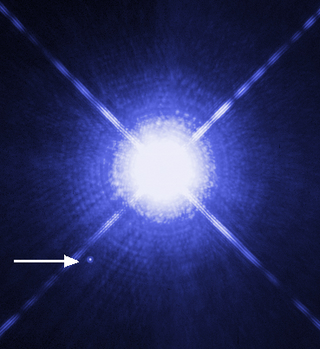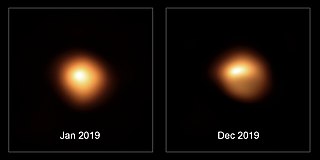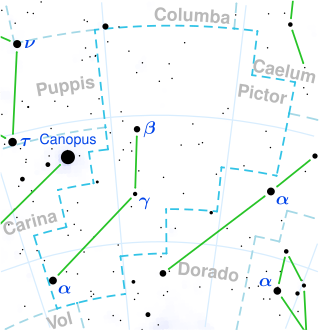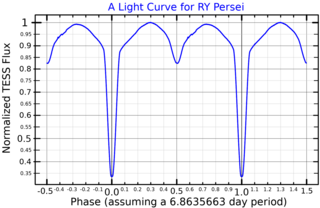Related Research Articles

Algol, designated Beta Persei, known colloquially as the Demon Star, is a bright multiple star in the constellation of Perseus and one of the first non-nova variable stars to be discovered.

A star is an astronomical object comprising a luminous spheroid of plasma held together by self-gravity. The nearest star to Earth is the Sun. Many other stars are visible to the naked eye at night; their immense distances from Earth make them appear as fixed points of light. The most prominent stars have been categorised into constellations and asterisms, and many of the brightest stars have proper names. Astronomers have assembled star catalogues that identify the known stars and provide standardized stellar designations. The observable universe contains an estimated 1022 to 1024 stars. Only about 4,000 of these stars are visible to the naked eye—all within the Milky Way galaxy.

A white dwarf is a stellar core remnant composed mostly of electron-degenerate matter. A white dwarf is very dense: its mass is comparable to the Sun's, while its volume is comparable to the Earth's. A white dwarf's low luminosity comes from the emission of residual thermal energy; no fusion takes place in a white dwarf. The nearest known white dwarf is Sirius B, at 8.6 light years, the smaller component of the Sirius binary star. There are currently thought to be eight white dwarfs among the hundred star systems nearest the Sun. The unusual faintness of white dwarfs was first recognized in 1910. The name white dwarf was coined by Willem Luyten in 1922.

A variable star is a star whose brightness as seen from Earth changes with time. This variation may be caused by a change in emitted light or by something partly blocking the light, so variable stars are classified as either:

In astronomy, the Roche lobe is the region around a star in a binary system within which orbiting material is gravitationally bound to that star. It is an approximately teardrop-shaped region bounded by a critical gravitational equipotential, with the apex of the teardrop pointing towards the other star (the apex is at the L1 Lagrangian point of the system).

Delta Capricorni, or δ Capricorni, is a binary star located 38,7 light-years from the Sun in the constellation of Capricornus. The system consists of an eclipsing binary, Delta Capricorni A, and two visual companions that are over 10 magnitudes fainter, labeled B and C. Delta Capricorni A's two components are designated Delta Capricorni Aa and Ab. The primary star, Aa, is a white giant and the combined light of Aa and Ab makes it the brightest star in the constellation.

Lambda Tauri is a triple star system in the constellation Taurus. In the Calendarium of Al Achsasi Al Mouakket, this star was designated Sadr al Tauri, which was translated into Latin as Pectus Tauri, meaning "the bull chest". In 1848, the light from this system was found to vary periodically and it was determined to be an eclipsing binary system—the third such discovered. The components of this system have a combined apparent visual magnitude of +3.37 at its brightest, making it one of the brighter members of the constellation. Based upon parallax measurements from the Hipparcos mission, the distance to this system is approximately 480 light-years.

Alpha Pictoris is the brightest star in the southern constellation of Pictor. It has an apparent visual magnitude of 3.27, which is bright enough to be viewed from urban areas in the southern hemisphere. This star is close enough for its distance to be measured using parallax shifts, which yields a value of roughly 97 light-years from the Sun, with a 5% margin of error. Alpha Pictoris has the distinction of being the south pole star of the planet Mercury.

Algol variables or Algol-type binaries are a class of eclipsing binary stars that are similar to the prototype member of this class, β Persei. An Algol binary is a system where both stars are near-spherical such that the timing of the start and end of the eclipses is well-defined. The primary is generally a main sequence star well within its Roche lobe. The secondary may also be a main sequence star, referred to as a detached binary or it may an evolved star filling its Roche lobe, referred to as a semidetached binary.

Stellar rotation is the angular motion of a star about its axis. The rate of rotation can be measured from the spectrum of the star, or by timing the movements of active features on the surface.

Asteroseismology studies the internal structure of the Sun and other stars using oscillations. These can be studied by interpreting the temporal frequency spectrum acquired through observations. In the same way, the more extreme neutron stars might be studied and hopefully give us a better understanding of neutron-star interiors, and help in determining the equation of state for matter at nuclear densities. Scientists also hope to prove, or discard, the existence of so-called quark stars, or strange stars, through these studies. Fundamental information can be obtained of the General Relativity Theory by observing the gravitational radiation from oscillating neutron stars.

Delta Pictoris, Latinized from δ Pictoris, is a binary star system in the southern constellation Pictor. It is visible to the naked with a combined apparent visual magnitude of 4.72. The system is located at a distance of approximately 1,300 light years from the Sun based on parallax measurements, and is drifting further away with a radial velocity of ~31 km/s. It is a runaway star system that is generating a bow shock as it moves through the interstellar medium.
The Applegate mechanism explains long term orbital period variations seen in certain eclipsing binaries. As a main sequence star goes through an activity cycle, the outer layers of the star are subject to a magnetic torque changing the distribution of angular momentum, resulting in a change in the star's oblateness. The orbit of the stars in the binary pair is gravitationally coupled to their shape changes, so that the period shows modulations on the same time scale as the activity cycles.

RS Canum Venaticorum is a binary star system in the northern constellation of Canes Venatici. It serves as the prototype to the class of RS Canum Venaticorum variables. The peak apparent visual magnitude of this system is below the level needed to observe it with the naked eye. It is located at a distance of approximately 443 light years from the Sun based on parallax, but is drifting closer with a net radial velocity of −14 km/s. Olin J. Eggen (1991) included this system as a member of the IC 2391 supercluster, but it was later excluded.

U Sagittae is an eclipsing binary star system in the northern constellation of Sagitta. It has been actively studied since its discovery in 1901. The maximum apparent visual magnitude of this system is 6.50, which is near the lower limit of visibility to the naked eye. The system is located at a distance of approximately 868 light years from the Sun based on parallax measurements, but is drifting closer with a radial velocity of −17 km/s. It is positioned about 2° from the middle of the Collinder 399 asterism, but lies much further away than the purported member stars.

TX Ursae Majoris is an eclipsing binary star system in the northern circumpolar constellation of Ursa Major. With a combined apparent visual magnitude of 6.97, the system is too faint to be readily viewed with the naked eye. The pair orbit each other with a period of 3.063 days in a circular orbit, with their orbital plane aligned close to the line of sight from the Earth. During the primary eclipse, the net brightness decreases by 1.74 magnitudes, while the secondary eclipse results in a drop of just 0.07 magnitude. TX UMa is located at a distance of approximately 780 light years from the Sun based on parallax measurements, but is drifting closer with a mean radial velocity of −13 km/s.

RW Tauri is a binary star system in the equatorial constellation of Taurus. It has the designation HD 25487 in the Henry Draper Catalogue, while RW Tauri is the variable star designation. With a peak apparent visual magnitude of 8.05, it is too faint to be visible to the naked eye. The distance to this system is approximately 940 light years based on parallax measurements.

VV Ursae Majoris is a binary star system in the northern circumpolar constellation of Ursa Major, abbreviated VV UMa. It is a variable star system with a brightness that cycles around an apparent visual magnitude of 10.19, making it too faint to be visible to the naked eye. The system is located at a distance of approximately 1,500 light years based on parallax measurements.

RY Persei is a variable star in the northern constellation of Perseus, abbreviated RY Per. It is an Algol variable with a period of 6.8635663 days, which indicates this is an eclipsing binary star system with an orbital plane oriented close to the line of sight from the Earth. The system has a maximum apparent visual magnitude of 8.50, which drops down to magnitude 10.25 during the eclipse of the primary component, then to 8.65 with the secondary eclipse. Based on parallax measurements, this system is located at a distance of approximately 2,960 light years from the Sun, but is drifting closer with a radial velocity of −12 km/s.

RT Persei is a variable star system in the northern constellation of Perseus, abbreviated RT Per. It is an eclipsing binary system with an orbital period of 0.84940032 d (20.386 h). At peak brightness the system has an apparent visual magnitude of 10.46, which is too faint to be viewed with the naked eye. During the eclipse of the primary this decreases to magnitude 11.74, then to magnitude 10.67 with the secondary eclipse. The distance to this system is approximately 628 light years based on parallax measurements. It is drifting closer with a heliocentric radial velocity of about −12 km/s.
References
- ↑ Ruciński, S. M. (1970), "An Upper Limit to the Chandrasekhar Polarization in Early Type Stars", Acta Astronomica , 20: 1, Bibcode:1970AcA....20....1R
- ↑ Chandrasekhar, S. (1946), "On the Radiative Equilibrium of a Stellar Atmosphere. X.", The Astrophysical Journal , 103: 351, Bibcode:1946ApJ...103..351C, doi:10.1086/144816
- ↑ Chandrasekhar, S. (1989). Selected Papers, Vol 2, Radiative transfer and negative ion of hydrogen. Chicago: University of Chicago Press. ISBN 9780226100920.
- ↑ Harrington, J. Patrick; Collins, George W. II (1968), "Intrinsic Polarization of Rapidly Rotating Early-Type Stars", The Astrophysical Journal , 151: 1051, Bibcode:1968ApJ...151.1051H, doi:10.1086/149504
- ↑ Hiltner, W. A. (1949), "Polarization of Radiation from Distant Stars by the Interstellar Medium", Nature , 163: 283, Bibcode:1949Natur.163..283H, doi: 10.1038/163283a0
- ↑ Kemp, J. C.; Henson, G. D.; Barbour, M. S.; Kraus, D. J.; Collins, G. W. II (1983), "Discovery of eclipse polarization in Algol.", The Astrophysical Journal , 273: L85, Bibcode:1983ApJ...273L..85K, doi:10.1086/184135
- ↑ Cotton, Daniel V.; Bailey, Jeremy; Howarth, Ian D.; Bott, Kimberly; Kedziora-Chudczer, Lucyna; Lucas, P. W.; Hough, J. H. (2017), "Polarization due to rotational distortion in the bright star Regulus", Nature Astronomy , 1: 690, arXiv: 1804.06576 , Bibcode:2017NatAs...1..690C, doi:10.1038/s41550-017-0238-6